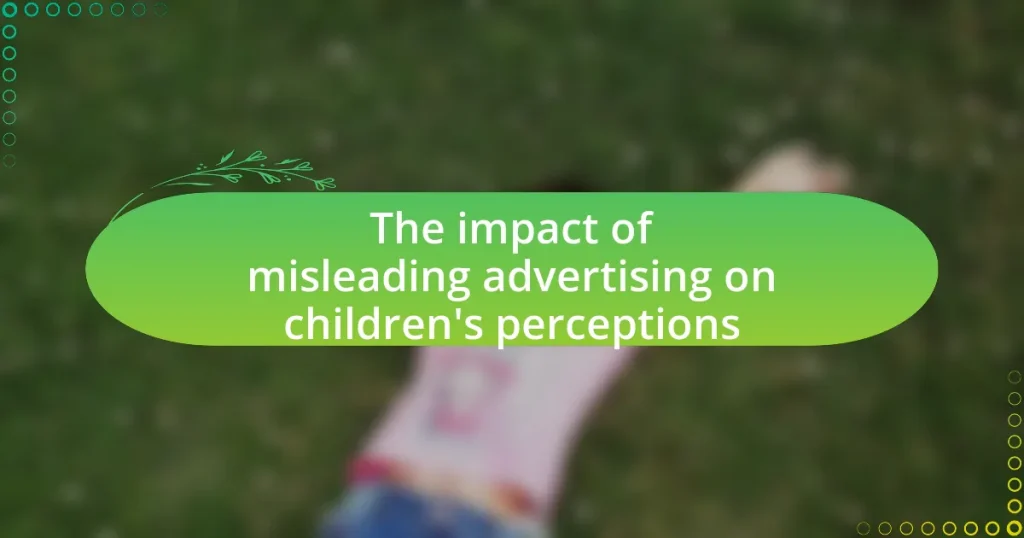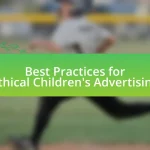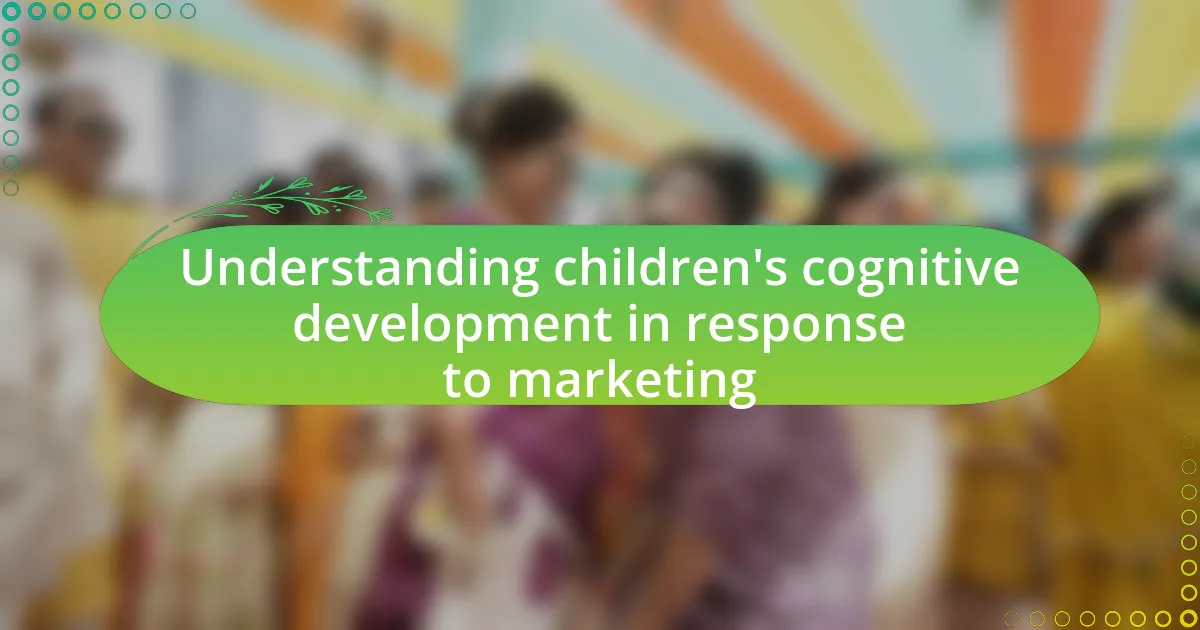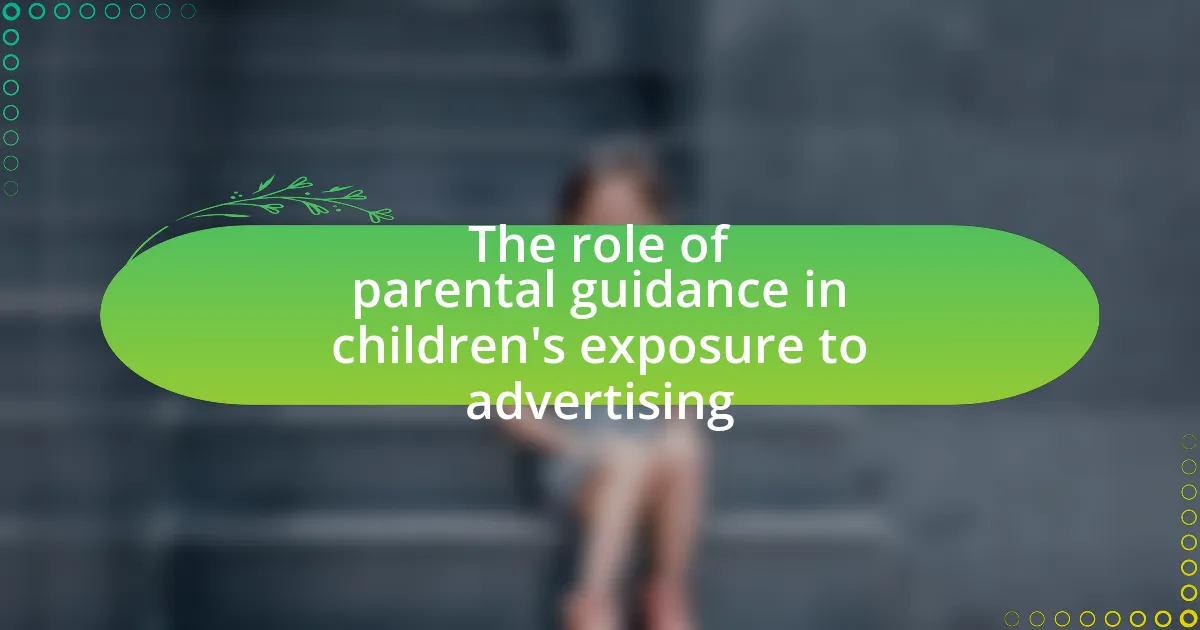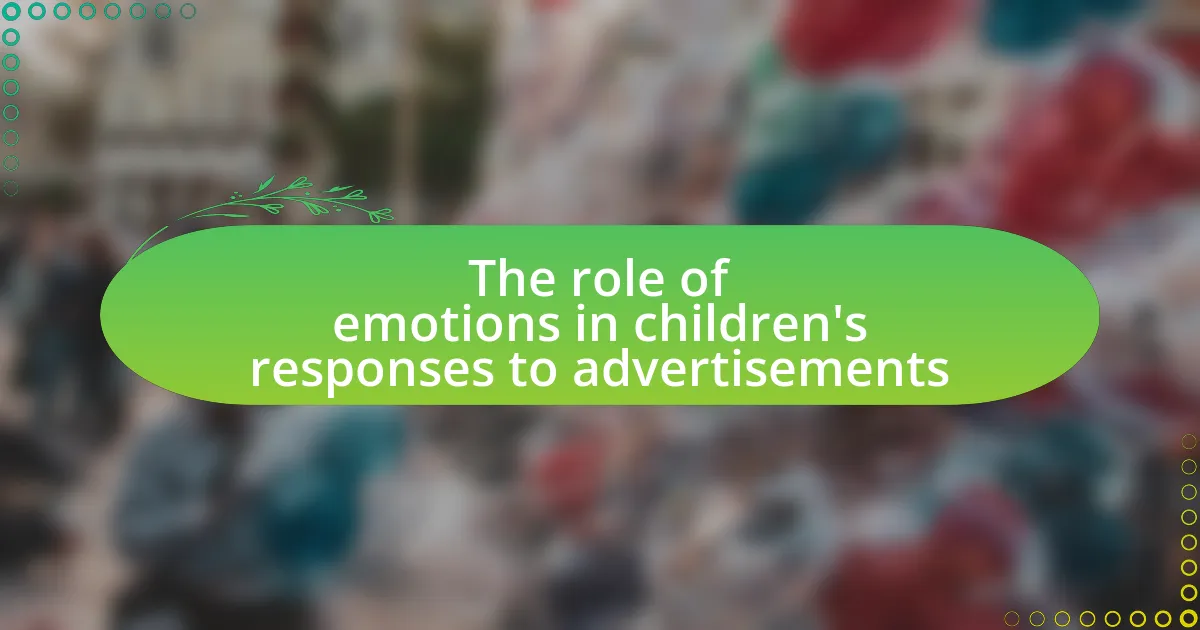The article examines the impact of misleading advertising on children’s perceptions, highlighting how deceptive marketing tactics distort their understanding of products and influence their consumer behavior. It discusses the cognitive vulnerabilities of children, particularly those under eight, who often accept advertising claims at face value, leading to unrealistic expectations and materialistic values. The article also explores the various techniques used in misleading advertising, such as emotional appeals and the use of popular characters, and emphasizes the importance of studying these effects to develop effective regulations and educational programs that protect children from exploitation in the marketplace. Additionally, it outlines strategies for parents and educators to help children critically evaluate advertisements and the role of regulations in mitigating misleading advertising practices.
What is the impact of misleading advertising on children’s perceptions?
Misleading advertising significantly distorts children’s perceptions by shaping their beliefs about products and influencing their desires. Research indicates that children are particularly vulnerable to deceptive marketing tactics, as they often lack the cognitive skills to critically evaluate advertisements. A study published in the Journal of Consumer Research found that children exposed to misleading ads were more likely to develop unrealistic expectations about product performance and quality. This distortion can lead to increased materialism and dissatisfaction when actual products do not meet the inflated claims presented in advertisements.
How does misleading advertising affect children’s understanding of products?
Misleading advertising significantly distorts children’s understanding of products by creating false perceptions about their features and benefits. Research indicates that children, particularly those under the age of eight, often lack the cognitive ability to critically evaluate advertising claims, leading them to accept misleading information as truth. For instance, a study published in the Journal of Consumer Research found that children exposed to deceptive advertisements were more likely to overestimate the effectiveness of a product, believing it to be superior to its actual capabilities. This misrepresentation can result in unrealistic expectations and poor decision-making regarding purchases, ultimately shaping their consumer behavior in a detrimental way.
What cognitive processes are influenced by misleading advertising in children?
Misleading advertising significantly influences cognitive processes in children, particularly attention, memory, and decision-making. Children are more susceptible to persuasive techniques used in advertising, which can lead to distorted perceptions of products. Research indicates that children often struggle to differentiate between advertising and reality, impacting their ability to critically evaluate information. For instance, a study by McAlister and Cornwell (2010) found that children aged 8 to 12 were more likely to remember misleading claims about products, demonstrating how advertising can distort their memory and understanding. This susceptibility can result in poor decision-making, as children may choose products based on misleading information rather than factual attributes.
How do children’s developmental stages affect their susceptibility to misleading advertising?
Children’s developmental stages significantly influence their susceptibility to misleading advertising, as younger children often lack the cognitive skills to critically evaluate advertisements. Research indicates that children aged 3 to 7 are particularly vulnerable because they tend to accept advertising claims at face value, believing that all marketed products are inherently good or beneficial. This is supported by findings from the American Psychological Association, which highlight that children under the age of 8 do not yet possess the ability to distinguish between entertainment and advertising, making them more likely to be misled by persuasive techniques used in ads. As children grow older, their cognitive abilities develop, allowing them to better understand persuasive intent and critically assess advertising messages, thus reducing their susceptibility to misleading claims.
Why is it important to study the impact of misleading advertising on children?
Studying the impact of misleading advertising on children is crucial because it directly influences their understanding of products and shapes their consumer behavior. Children are particularly vulnerable to deceptive marketing tactics due to their cognitive development stage, which makes it difficult for them to distinguish between reality and advertising. Research indicates that exposure to misleading advertisements can lead to unrealistic expectations about products, contributing to poor decision-making and unhealthy consumption habits. For instance, a study published in the Journal of Consumer Research found that children exposed to misleading food advertisements were more likely to choose unhealthy snacks over healthier options, demonstrating the significant effect of advertising on their choices. Understanding these impacts is essential for developing effective regulations and educational programs that protect children from exploitation in the marketplace.
What are the potential long-term effects of misleading advertising on children’s beliefs?
Misleading advertising can lead to long-term effects on children’s beliefs, including distorted perceptions of reality, unrealistic expectations, and materialistic values. Children exposed to deceptive marketing may develop a skewed understanding of products, believing that they can achieve happiness or social acceptance through consumption. Research indicates that children as young as eight can recognize persuasive intent but may still be influenced by misleading claims, leading to a reliance on advertising as a source of information. This reliance can foster skepticism towards genuine information and contribute to a consumer culture that prioritizes brand loyalty over critical thinking. Studies, such as those conducted by the American Psychological Association, highlight that repeated exposure to misleading advertisements can shape children’s attitudes and behaviors well into adulthood, reinforcing the importance of media literacy in mitigating these effects.
How does misleading advertising contribute to unhealthy consumer habits in children?
Misleading advertising contributes to unhealthy consumer habits in children by promoting products that are often high in sugar, fat, or salt while downplaying their negative health effects. Research indicates that children are particularly susceptible to persuasive marketing techniques, which can lead them to prefer unhealthy food options over healthier alternatives. For instance, a study published in the journal “Pediatrics” found that children exposed to food advertisements were more likely to choose unhealthy snacks, demonstrating a direct link between misleading marketing and poor dietary choices. This manipulation of children’s perceptions fosters a preference for unhealthy products, ultimately shaping their consumer habits in detrimental ways.
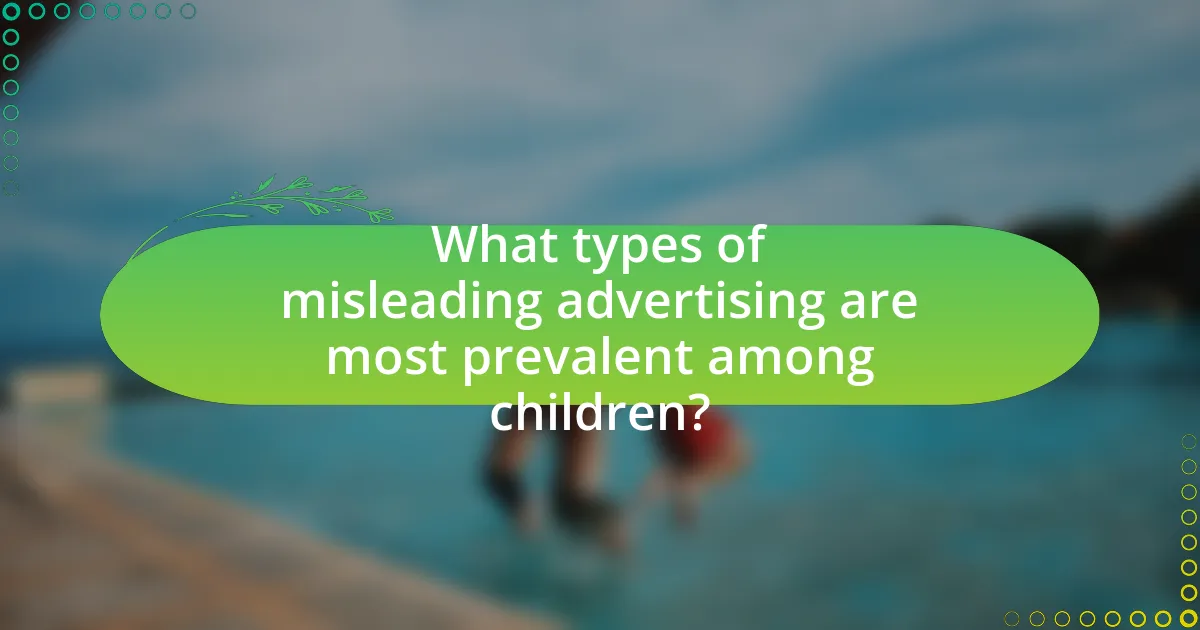
What types of misleading advertising are most prevalent among children?
The types of misleading advertising most prevalent among children include deceptive packaging, exaggerated claims, and the use of popular characters or celebrities. Deceptive packaging often involves products that appear larger or more appealing than they actually are, leading children to believe they are getting more value. Exaggerated claims frequently present products as having extraordinary benefits that are not substantiated, such as toys that promise to perform magical feats. Additionally, the use of popular characters or celebrities in advertisements can create a false sense of trust and desirability, influencing children’s perceptions and purchasing decisions. Research from the American Psychological Association indicates that children are particularly susceptible to these tactics, as they often lack the cognitive skills to critically evaluate advertising messages.
What are the common techniques used in misleading advertising targeted at children?
Common techniques used in misleading advertising targeted at children include the use of cartoon characters, exaggerated claims, and emotional appeals. Advertisers often employ cartoon characters to create a sense of familiarity and trust, making products more appealing to young audiences. Exaggerated claims, such as stating that a product can make children stronger or smarter, mislead children about the actual benefits. Emotional appeals, such as associating products with happiness or friendship, manipulate children’s feelings to influence their purchasing decisions. Research by the American Psychological Association highlights that these techniques can significantly distort children’s understanding of products and their value, leading to unrealistic expectations and consumer behavior.
How do animated characters and celebrities influence children’s perceptions?
Animated characters and celebrities significantly influence children’s perceptions by shaping their beliefs, preferences, and behaviors. Research indicates that children often view animated characters as relatable figures, which can lead to increased trust and affinity towards products endorsed by these characters. For instance, a study published in the Journal of Advertising Research found that children are more likely to remember and prefer products associated with animated characters compared to non-animated counterparts. Additionally, celebrities, particularly those popular among children, can create aspirational associations, leading children to emulate their behaviors and preferences. This phenomenon is supported by findings from the American Psychological Association, which highlight that children exposed to celebrity endorsements are more likely to develop positive attitudes towards the advertised products.
What role does emotional appeal play in misleading advertisements for children?
Emotional appeal plays a significant role in misleading advertisements for children by exploiting their developing emotional understanding and vulnerability. Advertisements often use bright colors, catchy jingles, and relatable characters to evoke feelings of happiness, excitement, or belonging, which can lead children to associate these emotions with the products being advertised. Research indicates that children are particularly susceptible to emotional manipulation, as they may not yet possess the critical thinking skills necessary to discern between genuine emotional connections and marketing tactics. For instance, a study published in the Journal of Consumer Research found that children aged 6 to 12 are more likely to be influenced by advertisements that evoke positive emotions, leading them to request products that may not be beneficial or necessary. This emotional manipulation can distort children’s perceptions of reality, making them believe that happiness or social acceptance is directly tied to the consumption of specific products.
How do different media platforms affect children’s exposure to misleading advertising?
Different media platforms significantly influence children’s exposure to misleading advertising by varying the types of content and the frequency of advertisements they encounter. For instance, television often presents ads during children’s programming, which can be designed to appeal directly to young audiences, leading to increased susceptibility to misleading claims. Research indicates that children aged 8 to 12 are particularly vulnerable to deceptive advertising tactics, as they may not fully understand the persuasive intent behind commercials (Linn, 2004, “Consuming Kids: The Hostile Takeover of Childhood,” The New Press).
In contrast, digital platforms, such as social media and video-sharing sites, utilize targeted advertising algorithms that can expose children to misleading ads based on their online behavior and preferences. A study by the American Psychological Association found that children exposed to online ads are more likely to believe in the claims made, as these ads often blend seamlessly with content, making it difficult for them to discern advertising from entertainment (American Psychological Association, 2017).
Thus, the nature of the media platform—whether traditional or digital—affects the extent and manner in which children are exposed to misleading advertising, impacting their perceptions and understanding of marketing messages.
What impact does television advertising have compared to online advertising for children?
Television advertising has a more significant impact on children’s perceptions compared to online advertising. Research indicates that children are more susceptible to the persuasive techniques used in television ads, which often feature colorful visuals and catchy jingles, leading to increased brand recognition and preference. A study published in the journal “Pediatrics” found that children aged 2 to 11 are exposed to an average of 12 television commercials per day, which can shape their preferences and behaviors more effectively than online ads, where distractions and multitasking are common. Furthermore, television ads often create a sense of urgency and excitement that can be more compelling than the typically less engaging online formats.
How does the use of social media influence children’s perceptions of products?
The use of social media significantly influences children’s perceptions of products by exposing them to targeted advertising and peer endorsements. Children often view social media as a trusted source of information, leading them to develop positive attitudes towards products that are popular among their peers or featured in influencer content. Research indicates that children aged 8 to 12 are particularly susceptible to social media marketing, with studies showing that 70% of children are influenced by social media when making purchasing decisions. This influence is compounded by the visual nature of platforms like Instagram and TikTok, where appealing imagery and engaging content can create a desire for products, regardless of their actual quality or suitability.
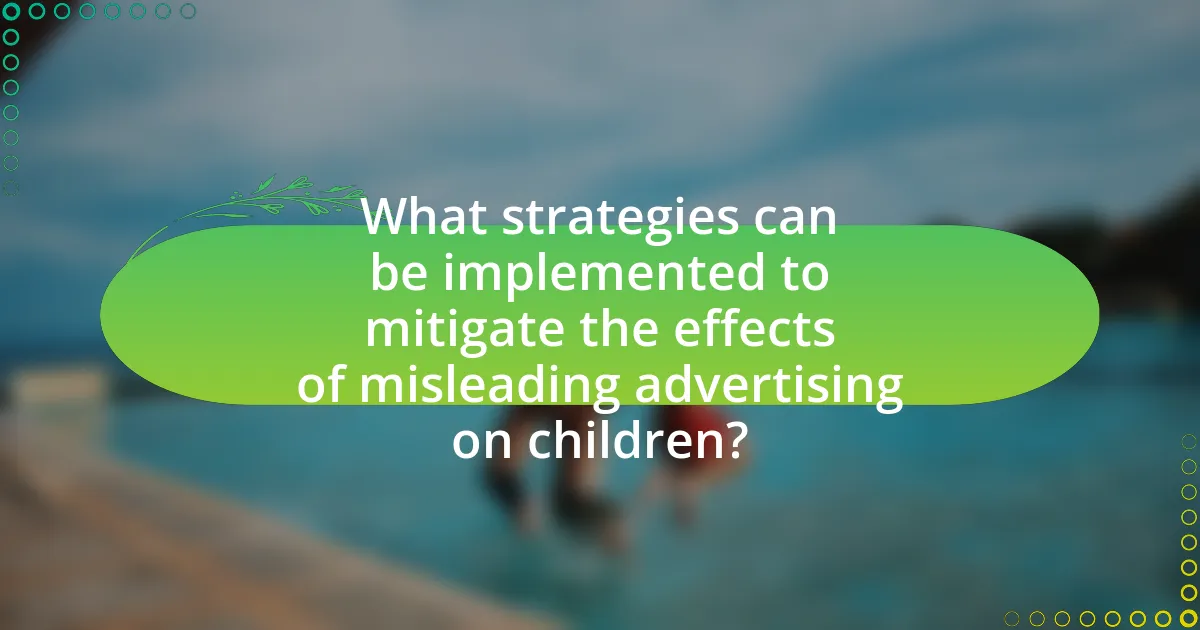
What strategies can be implemented to mitigate the effects of misleading advertising on children?
To mitigate the effects of misleading advertising on children, implementing stricter regulations on advertising content aimed at young audiences is essential. Regulatory bodies can enforce guidelines that require advertisements to be truthful and not exploit children’s naivety. For instance, the Federal Trade Commission (FTC) in the United States has established rules that prohibit deceptive advertising practices targeting children, which helps protect them from misleading claims. Additionally, educational programs can be introduced in schools to teach children critical thinking skills regarding media literacy, enabling them to discern between factual information and advertising tactics. Research indicates that children who receive media literacy education are better equipped to understand advertising intent and are less likely to be influenced by misleading ads.
How can parents and educators help children critically evaluate advertisements?
Parents and educators can help children critically evaluate advertisements by teaching them to analyze the content, intent, and techniques used in ads. This can be achieved through discussions that focus on identifying persuasive language, emotional appeals, and visual imagery that aim to influence consumer behavior. Research indicates that children as young as 8 years old can understand the persuasive intent of advertisements when guided appropriately (Livingstone & Helsper, 2006). By encouraging children to ask questions such as “What is the ad trying to sell?” and “Who benefits from this message?”, parents and educators can foster critical thinking skills. Additionally, using real-life examples of advertisements and engaging children in activities that require them to create their own ads can further enhance their understanding of advertising strategies and their potential impact on perceptions.
What resources are available for teaching children about advertising literacy?
Resources available for teaching children about advertising literacy include educational programs, online platforms, and interactive materials. For instance, the “Media Smarts” initiative provides comprehensive lesson plans and activities focused on advertising literacy, helping children critically analyze advertisements. Additionally, the “Admongo” website, developed by the Federal Trade Commission, offers games and resources designed to teach kids about advertising techniques and consumer awareness. Research indicates that early exposure to advertising literacy education can significantly enhance children’s ability to discern misleading advertisements, thereby improving their overall media literacy skills.
How can discussions about advertising be integrated into educational curricula?
Discussions about advertising can be integrated into educational curricula by incorporating critical media literacy programs that focus on analyzing advertisements and understanding their persuasive techniques. Research indicates that teaching students to critically evaluate advertising helps them recognize misleading claims and develop informed consumer behaviors. For example, a study by the American Psychological Association highlights that children exposed to media literacy education show improved skills in discerning advertising intent and identifying deceptive practices. This integration can occur through dedicated lessons, projects analyzing real advertisements, and discussions on the ethical implications of advertising, thereby fostering a more informed and critical perspective among students regarding the impact of misleading advertising on their perceptions.
What role do regulations play in protecting children from misleading advertising?
Regulations play a crucial role in protecting children from misleading advertising by establishing legal standards that restrict deceptive marketing practices aimed at young audiences. These regulations, such as the Children’s Online Privacy Protection Act (COPPA) in the United States, require advertisers to provide clear and truthful information, ensuring that children are not exposed to misleading claims about products. Studies have shown that children are particularly vulnerable to advertising tactics, as they may not possess the cognitive skills to critically evaluate marketing messages. By enforcing guidelines that limit the types of advertisements directed at children and mandate transparency, regulations help mitigate the risk of children developing skewed perceptions of products and brands.
What current laws exist to limit misleading advertising aimed at children?
Current laws that limit misleading advertising aimed at children include the Children’s Online Privacy Protection Act (COPPA) and the Federal Trade Commission (FTC) regulations. COPPA mandates that websites and online services directed at children under 13 must obtain parental consent before collecting personal information, thereby reducing the potential for misleading advertising. The FTC enforces guidelines that prohibit deceptive advertising practices, specifically targeting advertisements that could mislead children about the nature or benefits of products. These regulations are designed to protect children from exploitation and ensure that advertising is truthful and not misleading.
How effective are these regulations in practice?
The effectiveness of regulations on misleading advertising aimed at children is limited in practice. Studies indicate that despite existing regulations, children remain highly susceptible to misleading advertisements, as they often lack the cognitive ability to critically evaluate marketing messages. For instance, research published in the Journal of Consumer Research shows that children aged 8 to 12 are unable to distinguish between entertainment and advertising, leading to misinterpretation of promotional content. Furthermore, compliance monitoring is often inadequate, with many companies finding loopholes to circumvent regulations, thereby undermining their intended impact.
What practical tips can parents use to address misleading advertising with their children?
Parents can address misleading advertising with their children by engaging in open discussions about the content and intent of advertisements. This involves explaining how advertisements are designed to persuade and may not always present the full truth. Parents should encourage critical thinking by asking children questions about the ads they see, such as what the ad is trying to sell and whether the claims seem realistic. Additionally, parents can use real-life examples of misleading ads to illustrate their points, reinforcing the idea that not everything presented in media is accurate. Research indicates that children as young as 8 years old can understand the persuasive intent of advertising when guided appropriately, making it essential for parents to provide context and support in navigating these messages.
